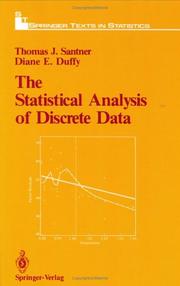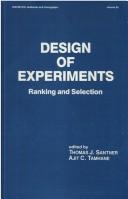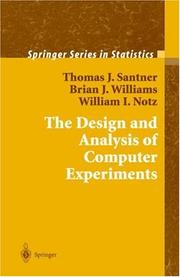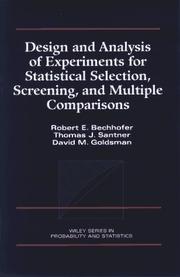| Listing 1 - 6 of 6 |
Sort by
|

ISBN: 0387970185 1461269865 1461210178 9780387970189 Year: 1989 Publisher: New York : Springer-Verlag,
Abstract | Keywords | Export | Availability | Bookmark
 Loading...
Loading...Choose an application
- Reference Manager
- EndNote
- RefWorks (Direct export to RefWorks)

ISBN: 0824772741 Year: 1984 Publisher: New York Dekker
Abstract | Keywords | Export | Availability | Bookmark
 Loading...
Loading...Choose an application
- Reference Manager
- EndNote
- RefWorks (Direct export to RefWorks)

ISBN: 0387954201 1441929924 1475737998 9780387954202 Year: 2003 Publisher: New York, N.Y. Springer
Abstract | Keywords | Export | Availability | Bookmark
 Loading...
Loading...Choose an application
- Reference Manager
- EndNote
- RefWorks (Direct export to RefWorks)
The computer has become an increasingly popular tool for exploring the relationship between a measured response and factors thought to affect the response. In many cases, the basis of a computer model is a mathematical theory that implicitly relates the response to the factors. A computer model becomes possible given suitable numerical methods for accurately solving the mathematical system and appropriate computer hardware and software to implement the numerical methods. For example, in many engineering applications, the relationship is described by a dynamical system and the numerical method is a finite element code. The resulting computer "simulator" can generate the response corresponding to any given set of values of the factors. This allows one to use the code to conduct a "computer experiment" to explore the relationship between the response and the factors. In some cases, computer experimentation is feasible when a properly designed physical experiment (the gold standard for establishing cause and effect) is impossible; the number of input variables may be too large to consider performing a physical experiment, or power studies may show it is economically prohibitive to run an experiment on the scale required to answer a given research question. This book describes methods for designing and analyzing experiments that are conducted using a computer code rather than a physical experiment. It discusses how to select the values of the factors at which to run the code (the design of the computer experiment) in light of the research objectives of the experimenter. It also provides techniques for analyzing the resulting data so as to achieve these research goals. It illustrates these methods with code that is available to the reader at the companion web site for the book. Thomas Santner has been a professor in the Department of Statistics at The Ohio State University since 1990. At Ohio State, he has served as department Chair and Director of the department's Statistical Consulting Service. Previously, he was a professor in the School of Operations Research and Industrial Engineering at Cornell University. He is a Fellow of the American Statistical Association and the Institute of Mathematical Statistics, and is an elected ordinary member of the International Statistical Institute. He visited Ludwig Maximilians Universität in Munich, Germany on a Fulbright Scholarship in 1996-97. Brian Williams has been an Associate Statistician at the RAND Corporation since 2000. His research interests include experimental design, computer experiments, Bayesian inference, spatial statistics and statistical computing. He holds a Ph.D. in statistics from The Ohio State University. William Notz is a professor in the Department of Statistics at The Ohio State University. At Ohio State, he has served as acting department chair, associate dean of the College of Mathematical and Physical Sciences, and as director of the department's Statistical Consulting Service. He has also served as Editor of the journal Technometrics and is a Fellow of the American Statistical Association. .
Mathematical statistics --- Experimental design --- Physical sciences --- Experiments --- Computer simulation --- Computer mathematics. --- Computer simulation. --- Applied mathematics. --- Engineering mathematics. --- Statistics . --- Computational Mathematics and Numerical Analysis. --- Simulation and Modeling. --- Mathematical and Computational Engineering. --- Statistical Theory and Methods. --- Statistics for Engineering, Physics, Computer Science, Chemistry and Earth Sciences. --- Statistical analysis --- Statistical data --- Statistical methods --- Statistical science --- Mathematics --- Econometrics --- Engineering --- Engineering analysis --- Mathematical analysis --- Computer modeling --- Computer models --- Modeling, Computer --- Models, Computer --- Simulation, Computer --- Electromechanical analogies --- Mathematical models --- Simulation methods --- Model-integrated computing --- Computer mathematics --- Electronic data processing --- Physical sciences - Experiments - Computer simulation

ISBN: 0471574279 Year: 1995 Publisher: New York (N.Y.): Wiley
Abstract | Keywords | Export | Availability | Bookmark
 Loading...
Loading...Choose an application
- Reference Manager
- EndNote
- RefWorks (Direct export to RefWorks)
Experimental design --- Analysis of variance --- Plan d'expérience --- Analyse de variance --- statistische analyse --- onderzoek --- operationeel onderzoek --- Design of experiments --- Statistical design --- Mathematical optimization --- Research --- Science --- Statistical decision --- Statistics --- Analysis of means --- ANOVA (Analysis of variance) --- Variance analysis --- Mathematical statistics --- Experiments --- Methodology --- Experimental design. --- Analysis of variance. --- Plan d'expérience
Book
ISBN: 1493988476 149398845X Year: 2018 Publisher: New York, NY : Springer New York : Imprint: Springer,
Abstract | Keywords | Export | Availability | Bookmark
 Loading...
Loading...Choose an application
- Reference Manager
- EndNote
- RefWorks (Direct export to RefWorks)
This book describes methods for designing and analyzing experiments that are conducted using a computer code, a computer experiment, and, when possible, a physical experiment. Computer experiments continue to increase in popularity as surrogates for and adjuncts to physical experiments. Since the publication of the first edition, there have been many methodological advances and software developments to implement these new methodologies. The computer experiments literature has emphasized the construction of algorithms for various data analysis tasks (design construction, prediction, sensitivity analysis, calibration among others), and the development of web-based repositories of designs for immediate application. While it is written at a level that is accessible to readers with Masters-level training in Statistics, the book is written in sufficient detail to be useful for practitioners and researchers. New to this revised and expanded edition: • An expanded presentation of basic material on computer experiments and Gaussian processes with additional simulations and examples • A new comparison of plug-in prediction methodologies for real-valued simulator output • An enlarged discussion of space-filling designs including Latin Hypercube designs (LHDs), near-orthogonal designs, and nonrectangular regions • A chapter length description of process-based designs for optimization, to improve good overall fit, quantile estimation, and Pareto optimization • A new chapter describing graphical and numerical sensitivity analysis tools • Substantial new material on calibration-based prediction and inference for calibration parameters • Lists of software that can be used to fit models discussed in the book to aid practitioners.
Experimental design. --- Mathematical statistics. --- Statistics. --- Engineering mathematics. --- Statistical Theory and Methods. --- Statistics for Engineering, Physics, Computer Science, Chemistry and Earth Sciences. --- Mathematical and Computational Engineering. --- Engineering --- Engineering analysis --- Mathematical analysis --- Statistical analysis --- Statistical data --- Statistical methods --- Statistical science --- Mathematics --- Econometrics --- Statistical inference --- Statistics, Mathematical --- Statistics --- Probabilities --- Sampling (Statistics) --- Statistics . --- Applied mathematics.
Digital
ISBN: 9781493988471 Year: 2018 Publisher: New York, NY Springer
Abstract | Keywords | Export | Availability | Bookmark
 Loading...
Loading...Choose an application
- Reference Manager
- EndNote
- RefWorks (Direct export to RefWorks)
This book describes methods for designing and analyzing experiments that are conducted using a computer code, a computer experiment, and, when possible, a physical experiment. Computer experiments continue to increase in popularity as surrogates for and adjuncts to physical experiments. Since the publication of the first edition, there have been many methodological advances and software developments to implement these new methodologies. The computer experiments literature has emphasized the construction of algorithms for various data analysis tasks (design construction, prediction, sensitivity analysis, calibration among others), and the development of web-based repositories of designs for immediate application. While it is written at a level that is accessible to readers with Masters-level training in Statistics, the book is written in sufficient detail to be useful for practitioners and researchers. New to this revised and expanded edition: • An expanded presentation of basic material on computer experiments and Gaussian processes with additional simulations and examples • A new comparison of plug-in prediction methodologies for real-valued simulator output • An enlarged discussion of space-filling designs including Latin Hypercube designs (LHDs), near-orthogonal designs, and nonrectangular regions • A chapter length description of process-based designs for optimization, to improve good overall fit, quantile estimation, and Pareto optimization • A new chapter describing graphical and numerical sensitivity analysis tools • Substantial new material on calibration-based prediction and inference for calibration parameters • Lists of software that can be used to fit models discussed in the book to aid practitioners.
Statistical science --- Mathematical statistics --- Mathematics --- Applied physical engineering --- Engineering sciences. Technology --- Computer. Automation --- ICT (informatie- en communicatietechnieken) --- economie --- webdesign --- statistiek --- wiskunde --- ingenieurswetenschappen --- statistisch onderzoek
| Listing 1 - 6 of 6 |
Sort by
|

 Search
Search Feedback
Feedback About
About Help
Help News
News